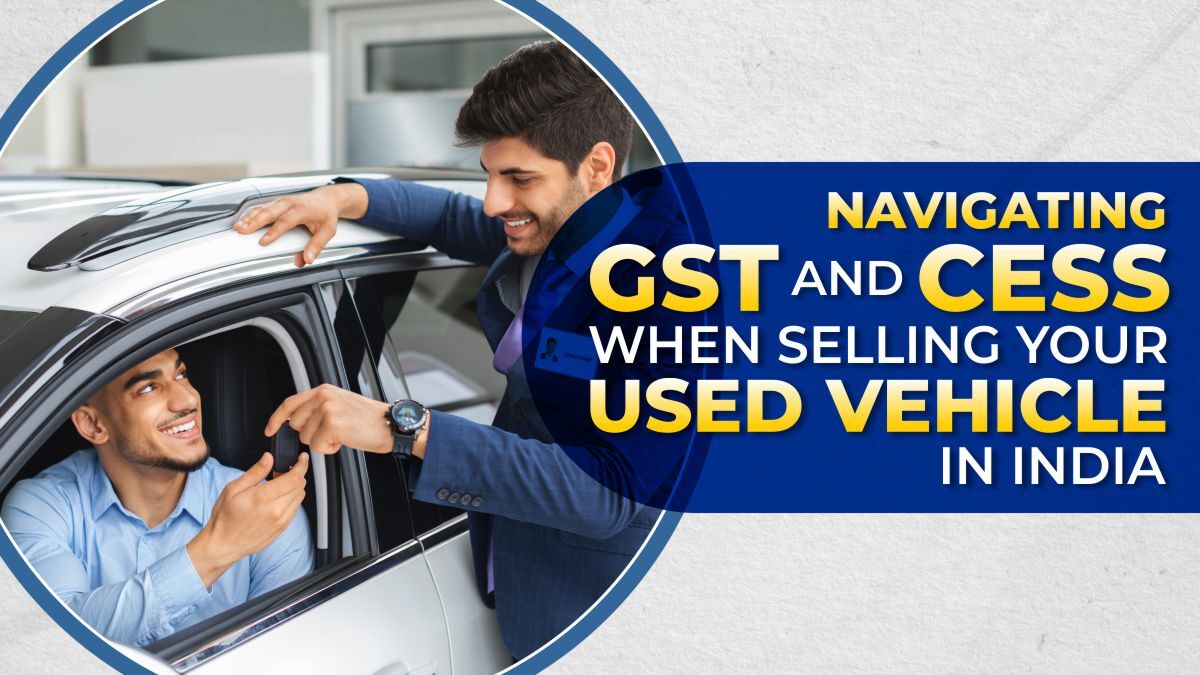
Are you planning to sell your used vehicle? Understanding the tax implications, especially Goods and Services Tax (GST) and cess, is crucial. Let’s delve into what you need to know to make the process smoother.
GST on Used Vehicles
When selling a used vehicle, GST is applicable only on the margin of supply. This means the difference between the selling price and the purchase price of the vehicle. The applicable rate depends on the type of vehicle and its usage:
For Cars
Within Three Years of Purchase: GST is applicable at the rate of 28% on the margin value.
After Three Years: The GST rate reduces to 18%.
For Two-Wheelers
Regardless of Ownership Duration: The GST rate on the margin value of used two-wheelers is 18%.
Understanding Cess
Cess is an additional tax levied to fund specific government initiatives. In the case of used vehicles, a cess known as the “Compensation Cess” is applicable. It is charged on top of the GST rate and varies based on the type of vehicle:
For Cars and SUVs
Petrol/LPG/CNG Vehicles with Engine Capacity up to 1200cc: Attract a cess of 1%.
- Diesel Vehicles with Engine Capacity up to 1500cc: Subject to a cess of 3%.
- Vehicles with Higher Engine Capacities: The cess is higher.
For Two-Wheelers
- Motorcycles with Engine Capacity Exceeding 350cc: A cess of 3% is applicable.
Let’s break down this topic with specific examples:
Example 1: Selling a Three-Year-Old Car
Suppose you’re selling a car that you purchased three years ago for Rs. 8 lakhs and are now selling for Rs. 6 lakhs. Here’s how GST and cess would apply:
GST Calculation: GST is applicable on the margin value, which is the selling price minus the purchase price. In this case, the margin value is Rs. 6 lakhs (selling price) minus Rs. 8 lakhs (purchase price), resulting in a margin value of -Rs. 2 lakhs.
Since the margin value is negative, no GST is applicable in this scenario.
Cess Calculation: If the car is petrol/LPG/CNG with an engine capacity up to 1200cc, a cess of 1% would be applicable on the selling price of Rs. 6 lakhs.
Example 2: Selling a Five-Year-Old Motorcycle
Consider selling a motorcycle you’ve owned for five years. You bought it for Rs. 1.5 lakhs and are selling it for Rs. 80,000. Here’s how GST and cess would work:
GST Calculation: Again, GST is applied on the margin value. The margin value here is Rs. 80,000 (selling price) minus Rs. 1.5 lakhs (purchase price), resulting in a margin value of -Rs. 70,000.
As the margin value is negative, no GST is applicable.
Cess Calculation: For motorcycles with an engine capacity exceeding 350cc, a cess of 3% would apply to the selling price of Rs. 80,000.
Example 3: Selling a Two-Year-Old SUV
Now, let’s say you’re selling an SUV you purchased two years ago for Rs. 12 lakhs and are selling it for Rs. 10 lakhs. Here’s the breakdown:
GST Calculation: The margin value is Rs. 10 lakhs (selling price) minus Rs. 12 lakhs (purchase price), resulting in a margin value of -Rs. 2 lakhs.
No GST applies due to the negative margin value.
Cess Calculation: If it’s a diesel SUV with an engine capacity up to 1500cc, a cess of 3% would be applicable on the selling price of Rs. 10 lakhs.
Key Points to Remember
- Calculate Margin Value: Determine the margin value by deducting the purchase price of the vehicle from the selling price.
- Check Applicable Rates: Verify the GST and cess rates applicable to your vehicle category and its usage duration.
- Maintain Documentation: Keep records of the purchase and sale transactions, as well as relevant documents like invoices and registration certificates.
- Consult Professionals: When in doubt, seek guidance from tax professionals or experts familiar with GST regulations.
Conclusion
Selling a used vehicle involves navigating various tax implications, including GST and cess. By understanding these aspects and ensuring compliance with relevant regulations, you can streamline the selling process and avoid any unforeseen tax liabilities. Remember to stay informed, plan ahead, and seek assistance when needed to make your transaction hassle-free.
